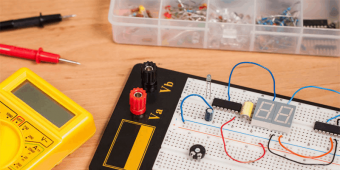Peopleanalytics101 Course
Tags: HR Analytics
Conceptualize the Basics of Statistical Model Building.
Last updated 2022-01-10 | 4
- A Step by Step Approach to solve Business Problems in the area of People Analytics.- Understand the concepts of Statistical model building.
- Journey of Analytics.
What you'll learn
* Requirements
* Anyone can take this course. You do not need any prior knowledge or additional equipment.Description
- A Step by Step Approach to solve Business Problems in the area of People Analytics.
- Understand the concepts of Statistical model building.
- Journey of Analytics.
- HR analytics and its importance.
- Employee life cycle the areas where you can use analytics.
- Get an understanding of HR metrics and the Journey from Metrics to Analytics.
- Identify a business problem and its importance. You’ll also learn how to convert a business problem into statistical problem.
- Understand the science behind gathering the data from various sources and how to do it right.
- Understand how to create an efficient data dictionary for better understanding and future reference.
- Identify the dependent and independent variable in your dataset.
- Understand and learn about various file formats in which the data is stored Understand the steps involved in data preparation.
- Various methods to measure Central Tendency, Variability and Shape of data.
- Understand the steps involved in hypothesis testing, Univariate and Bi-variate Analysis.
- Learn the concepts of Feature Engineering.
- R and Rstudio: Installation, importing files and installation of packages.
- Understand the concept of Machine Learning – Supervised and Unsupervised Learning Techniques.
Course content
20 sections • 67 lectures
Journey of Analytics Preview 01:11
In this chapter, you will learn
What exactly is Analytics?
Why analytics is required in the first place?
What is analytics maturity model?
What tools do we need for data analytics?
What are the areas where we can apply analytics?
And the most important we will help you with step by step approach to solve any business problem faced by you on a day to day basis. We call it ANATOMY OF STATISTICAL MODEL here at unlockHR.com.
What is Analytics and Why it is important? Preview 02:13
Analytics Maturity Model Preview 14:01
Extras Preview 00:07
Anatomy of Statistical Modeling Preview 07:44
Understanding Business Problem Preview 09:35
Your basic understanding of how HR works must be clear by now. Let's move to the next step.
Here in this chapter, you will learn :
What is classified as a business problem?
What are the objectives of this project?
How you will define the problem is also a problem. Don't worry we got it covered for you.
Next thing you need to learn is to understand the problems you came up with and what are the requirements to solve that.
And at the end of this chapter, you will learn the most important part, i.e. how you will convert your business problem into the statistical problem.
Knowledge Check (Business Problem Understanding)
Installation of R & R Studio Preview 18:17
Full code Preview 00:05
Introduction to Data Discovery & Collection Preview 01:52
From this chapter, we are going to prepare you for the analytics part.
First of all, we will start with data architecture.
Then we learn to identify all the data sources and create preparation of data list.
Next thing you will learn is how to collect the data for further analysis.
Once the data is collected you need to understand the data first.
Next step in this learning process would be the data import.
Don't you wanna know whether the data you collected is correct or not or how you will do that in R. Don't worry guys we have covered that as well.
HR Data Architecture Preview 02:59
Data list preparation and identification of Data Sources Preview 03:02
Collect initial Data Preview 07:51
Define Variables and create Data Dictionary Preview 03:19
Data Verification Preview 02:53
Knowledge Check (Data Collection)
Resources Preview 00:03
Defining Variables and Data Dictionary Preview 10:03
Data Verification Preview 15:31
Introduction to Data Preparation Preview 03:26
Well, the most awaited moment is here, now we will start working with data.
The first thing we will learn is how we can get some insight with the help of Uni-variate analysis.
You must have found some problems with the data. Like null values and outliers, that is why the next thing is data cleaning.
After data cleaning, we will move to feature engineering where you will learn what is a feature, why do we need feature engineering in the first place and how do we do feature engineering.
You will learn what is feature creation, variable transformation, and variable reduction.
Great we have prepared the data halfway, next thing we will perform analysis on more that one variable and test some hypothesis. Ohh.. I mean how you will test the hypothesis.
Don't worry we will teach every bit of it in a very simple way.
Next thing we will learn how to get rid of unwanted variables in the data and why do we need to do that.
Finally, you are ready to apply machine learning algorithms, but before that, we will learn to divide our data set into two parts.
To know why let's start this chapter.
Uni-Variate Analysis Preview 23:04
Missing value treatment Preview 07:27
Outlier Detection & Treatment Preview 08:22
Feature Engineering - Variable Creation Preview 10:21
Feature Engineering - Variable Transformation Preview 15:17
Feature Engineering - Dimension Reduction Preview 14:26
Hypothesis Testing and Bi-Variate Analysis Preview 22:50
Data Split Preview 04:37
Knowledge Check (Data Preparation)
Univariate Analysis Preview 17:09
Feature Engineering Part - 1 Preview 11:52
Bi-Variate Analysis Part - 1 (Categorical- Categorical) Preview 24:19
Bi-Variate Analysis Part - 2 (C-C Hypothesis Testing) Preview 09:25
Bi-Variate Analysis Part - 3 (Numerical - Categorical) Preview 23:35
Bi-Variate Analysis Part - 4 (Numerical - Categorical Hypothesis Testing) Preview 09:44
Feature Engineering Part - 2 (Dummy Variable Creation) Preview 09:13
Data Split Preview 07:07
Model Selection & Building Preview 20:55
In this chapter, you will learn
What is the model and model building?
We will help you that with some real-life examples which you see on a day to day basis.
Next thing in the line is “what is machine learning”?
What are the types of machine learning algorithms?
And the most important thing you will learn is what type of model you fit in what type of business problem.
After this chapter, you will be well versed with choosing appropriate algorithms.
Knowledge Check (Model Selection)
Random Forest Theory and Code Preview 23:09
Understanding GINI Impurity Preview 07:38
Introduction to Model Evaluation Preview 05:59
In this chapter you will learn:
Is your model giving correct result? You need to check that too. This is what you will learn first in this chapter.
What are the different unwanted types of models?
What are various methods to do model evaluation?
How you can evaluate the regression model?
How you can evaluate classification models?
Next, you will learn What are the various techniques you need to know while model evaluation as well.
Regression Model Evaluation Preview 14:03
Classification Model Evaluation Preview 27:03
Knowledge Check (Model Evaluation)
Random Forest Model Evaluation Preview 14:39
Conclusion Preview 06:06
Information Regrading Bonus Lecture Preview 00:05
1. Tools for Analytics Preview 18:10
2. Areas of Business Analytics Preview 05:45
Knowledge Check (Journey of Analytics)
3. What is Human Resources and its Importance Preview 02:48
Before we move to analytics, we will first tell you the basics of Human resources. It will help you understand the business problem in a more efficient way. In this chapter, you will learn
We will start with, what is Human Resource aka HR?
What is the importance of HR in any organization?
We will discuss in detail what is the employee life cycle and how analytics can be applied to the employee life cycle.
What are the Critical areas in HR where we need to apply analytics.
4. Key objectives of HR Analytics Preview 03:38
5. People Analytics applied to Employee Life Cycle Preview 04:24
6. Critical Areas of People Analytics Preview 09:12
7. Introduction to HR Metrics Preview 03:37
Next in line are:
What are the critical areas of people analytics like talent acquisition, training, etc?
What are HR Matrices?
Apart from this, you will also learn about HR Metrics, critical areas of HR metrics.
And finally, we will take you to journey from HR metrics to Analytics.








 This course includes:
This course includes:






